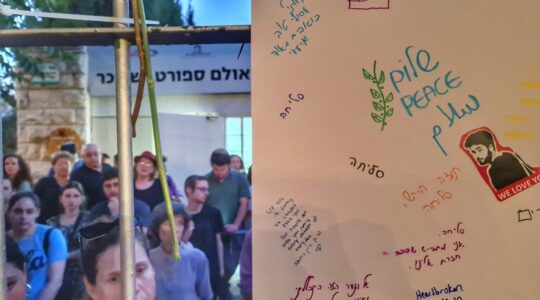At first glance, the red menorah symbol adorning the black T-shirt worn by Igor Kolomoysky doesn’t seem too strange for a casually dressed Ukrainian Jewish billionaire who has poured millions into Jewish causes and also happens to be a newly appointed regional governor in eastern Ukraine.
However, a closer inspection of the menorah reveals that it’s actually a Jew-ified variant of Ukrainian nationalist symbols accompanied by the enigmatic inscription “Zhidbanderovets,” which translated means “Yid-Banderite.”
The photo, which became something of a Facebook hit, turned out to be a fake. “It’s a photoshock,” the image’s creator, Kiev-based satirist and Putin critic Dmitriy Chekalkin, told the Ukrainian Jewish website Evreiskiy.Kiev.UA, describing a photoshopped image meant to shock.
The image has garnered thousands of likes and shares from Russian-speaking Facebook users , drawing a mix of online approval and outrage amid tensions over the Ukraine crisis and the stance of the country’s Jews.
So what on earth is a “Yid-Banderite”?
A “Banderite” refers to admirers of the late Ukrainian nationalist figure Stepan Bandera, who fought alongside — and later against — the Nazis in the 1940s and whose troops massacred Ukrainian Jews.
The term “Zhidbanderovets” has been popping up recently to describe Jewish supporters of the Ukrainian revolution.
“This neologism describes Jews who are allied with Ukrainian nationalists. For the most part, these same Jews use the term,” the Evreisky.Kiev.UA article explained.
These Jews are using the term to mock those who accuse the new Ukrainian government of anti-Semitism. After all, if the new government is so anti-Semitic, would so many Ukrainian Jews like Kolomoysky be supporting it?
According to Evreisky.Kiev.UA, a new Odessan joke has emerged that sounds a similar note:
OLEG: You’re a fascist and a Banderite!
SHMUEL: I know. Everyone’s saying it. Our whole synagogue is like that!
The appearance of the term “Zhidbanderovets” speaks to how Ukraine’s Jews and historic anti-Semitism have become heated points of contention in the fight over the country’s future.
Bandera does have his fans among contemporary Ukrainian revolutionaries. The iconic red-and-black flag of Bandera’s UPA, Ukrainian Insurgent Army, was a frequent sight in Independence Square, the epicenter of Ukraine’s winter revolution. The city of Lviv, a stronghold of Ukrainian nationalism, even has a street named after Bandera.
For some Ukrainians, especially in western Ukraine, Bandera represents a heroic tradition of fighting for self-determination — against the Soviet Union, and eventually against the Nazis.
But for many Russians and Jews, Bandera is a dark symbol of Ukrainian ultranationalism and its excesses. An article on the website of Yad Vashem states that “Bandera and his people considered the Soviets and the Jews their main enemies.”
Bandera initially collaborated with the Nazis against the Soviet Union, briefly establishing an independent Ukrainian republic in 1940 under German protection. In addition, Bandera’s followers were responsible for bloody pogroms, as well as the ethnic cleansing of Poles from what is today western Ukraine.
“Banderite” is one of the many terms — along with “fascist” and “neo-Nazi” — that Russian President Vladimir Putin and his allies have used to describe Ukraine’s current government, which came to power after the violent ouster of President Viktor Yanukovych.
Natan Khazin, a former Israeli commando who led a street-fighting team in Kiev during the recent Ukrainian revolution, seems unconcerned about being labeled a “Banderite.”
“As soon as I heard it, I said that I’d rather be called a ‘Zhido-Banderist’ than a ‘Zhido-Muscovite,’” Khazin said in an interview with an online Ukrainian media outlet (translated by the Forward).
In addition to the photoshopped Kolomoysky picture, Chekalkin — who identified himself on Facebook as a Hebrew speaker — has created several satirical “Zhidbanderovets” images. He gave Bandera’s UPA flag a Jewish makeover, cleverly illustrating the term “Zhidbanderovets” with a menorah, a Star of David and even peyot juxtaposed with UPA colors and the Ukrainian national symbol, a trident.
JTA contacted Kolomoysky’s representatives in Dniepropetrovsk, where he has been appointed to serve as governor, to ask about the doctored image and the term that comes along with it.
“Yes, the Dnepropetrovsk residents have called the governor a ‘Zhidobanderovets’ for some time,” Kolomoysky representative Marina Kozinetz said. “But this joking term has neither an anti-Semitic nor an anti-Ukrainian subtext.”
JTA has documented Jewish history in real-time for over a century. Keep our journalism strong by joining us in supporting independent, award-winning reporting.







